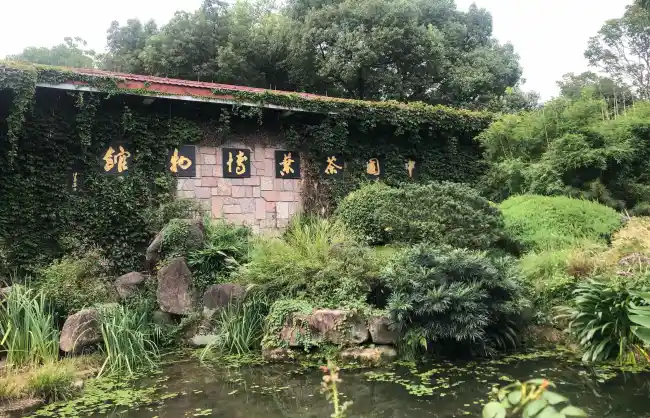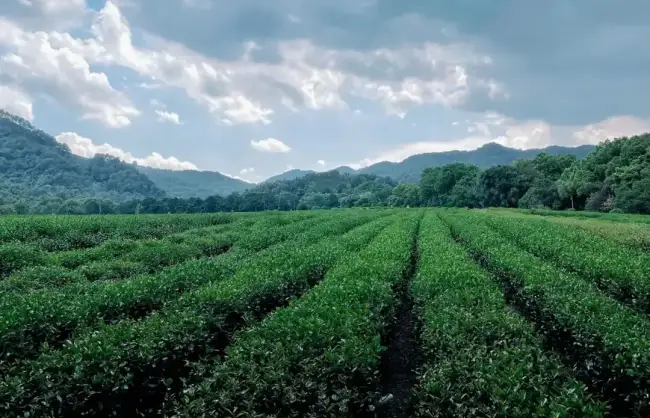Tea has a history of at least 4,700 years in China. China National Tea Museum in Hangzhou, Zhejiang province is the only museum in China dedicated to tea and tea culture. At its entrance, it is written in large Chinese characters, “中国茶叶博物馆.” The museum has a massive area of 11.6 acres (4.7 hectares).
There are five exhibition halls at China National Tea Museum, showcasing various tea types, tea production, and the rich tea history and culture in China. The exhibitions are in both Chinese and English. You’ll have the opportunities to sample different types of tea, witness tea ceremonies, join tea art lessons, and walk around the tea plantations.
Fast Facts about China National Tea Museum
- Address: No. 88, Longjing Road, Shuangfeng Village, Xihu District, Hangzhou, Zhejiang, China
- Operating hours: May 1 – October 7, 9:00-17:00; October 8 – April 30, 8:30-16:30 (closed on Mondays; open on public holidays)
- Ticket price: free
- Recommended visit time: 2-3 hours
- Best time of the year: all seasons
- Suited to: tea lovers, culture enthusiasts, nature lovers

What to See and Do in China National Tea Museum
1. Explore five exhibition halls
At China National Tea Museum, there are five exhibition halls each showcasing different aspects of Chinese tea.
- The Chinese Tea Evolution Hall displays a splendid collection of domestic and imported teas, the tea production process, and the evolution of Chinese tea.
- The Tea Ware Hall showcases the historical evolution of Chinese tea ware. Tea wares are an important part of Chinese tea culture. They have great artistic value and can also be a symbol of status. You’ll see exquisite antique tea sets crafted by skilled artisans.
- The Tea Custom Hall introduces a wide range of customs and etiquettes associated with tea from different regions and periods in China, including Yunnan, Sichuan, Tibet, Fujian, Guangdong during Ming and Qing dynasties.
- Admire different forms of artistic expressions associated with tea in Tea Art Hall. You’ll see tea paintings, calligraphy, seals, pottery, and sculptures beautifully capturing Chinese people’s relationship with tea.
- Lastly, the Tea Friendship Hall sheds light on the global impact of tea and the cultural exchanges between China and other nations.
2. Taste various kinds of Chinese tea
Sample a wide range of Chinese teas including green tea, black tea, oolong tea, white tea, yellow tea, dark tea, and floral tea. It’ll open up your mind to flavors and aromas that you never associated with tea before, ranging from sweet and bitter to floral, fruity, nutty, and smoky.
If you wish to bring the experience home, the museum shop and nearby tea houses have plenty of options.
3. Witness traditional tea ceremony
Witness a traditional tea ceremony performed by skilled tea masters while sampling tea. Appreciate the thought and skill that go into every aspect of tea drinking in China, from holding a teacup to brewing tea. It is truly an artistic performance. You’ll gain an understanding of the role of tea in social occasions.
4. Learn about the history and culture of tea in China
Get to know the profound historical and cultural significance of tea in China and around the world, its origins, development, classification, health benefits, ceremonies, arts, literature, philosophy, as well as its global influence. Tea played an important role in inspiring trade, famously along the Silk Road, and in shaping cultures and lifestyles.
5. Walk around tea plantations
After learning about different aspects of Chinese tea, take a stroll through the tea bushes in the green tea plantations surrounding the museum. The plantations are famous for producing exceptional teas like Longjing. If you want a more intimate experience, visit nearby tea villages such as Meijiawu Village and Longjing Village.
Related reading: Top 10 Things to Do in Hangzhou

Best Time to Visit China National Tea Museum
The best time for your Hangzhou tour to China National Tea Museum depends on your expectation for your trip, what to see and do.
Spring (March to May) is perfect for a hands-on experience at the tea plantations. Join the locals for tea picking and processing while immersing yourself in the beautiful green bushes.
If you travel to Hangzhou in the summer (June to August), the weather can get pretty hot and humid. Seek shade at the tea farms, enjoy the cooling breeze, while sampling local fresh green tea.
Autumn (September to November) is a beautiful season in Hangzhou with pleasant and cool weather. It’s the time for golden foliage, ripe fruits and perfect for black tea and oolong tea.
In the winter (December to February), the tea fields are covered in frost or snow. Warm yourself up in the cold and dry weather sipping on dark tea or flower tea.
How to Get to China National Tea Museum
By bus: Take either bus NO. 27 or Y3 (Tourism Bus Line 3) and get off at Shuangfeng Station. It’s only a short walk from China National Tea Museum.
By taxi: Take a taxi from anywhere in Hangzhou to China National Tea Museum. The fare from West Lake is around $6 (CNY 40).
By bike: Rent a bicycle from West Lake or nearby areas and for a scenic ride along Longjing Road to China National Tea Museum. It’s about 5 miles (8 kilometers), a 30-minute ride.
By private car: Arranging for a private car is the easiest way to get to the museum and around Hangzhou.
The table below shows a summary of transportation options, costs, and estimated durations:
| Transportation | Cost | Duration |
| Bus | $0.3 (CNY 2) | 40 minutes from West Lake |
| Taxi | $6 (CNY 40) | 20 minutes from West Lake |
| Bike | $1.5 (CNY 10) per hour | 30 minutes from West Lake |
| Private car | Varies by service | Flexible |
Attractions nearby China National Tea Museum
Longjing Tea Village is a scenic tea village nestled in the hills southwest of West Lake. It is about a 10-minute drive from China National Tea Museum. Experience local tea culture, taste Longjing tea, and admire the lush plantations.
Lingyin Temple is Hangzhou’s most renowned Buddhist temple 2.3 miles (3.7 kilometers) from China National Tea Museum. It boasts magnificent halls, statues, pagodas, and beautiful surroundings that reflect centuries of history and spirituality.
Taiziwan Park is a beautiful park south of the Su Causeway. It is the perfect place for a walk amidst beautiful woodlands, ponds, lakes, rose gardens, and lush lawns. It is particularly lovely during the spring cherry blossom season.
Santai Pavilion on Santai Hill has a panoramic view of West Lake and Hangzhou. You’ll see paintings dating back to Ming dynasty.
Yanxia Cave is also known as the Three Sages Cave with Buddhist statues, amazing limestone formations and a spiritual significance.
Hangzhou Tours to China National Tea Museum









